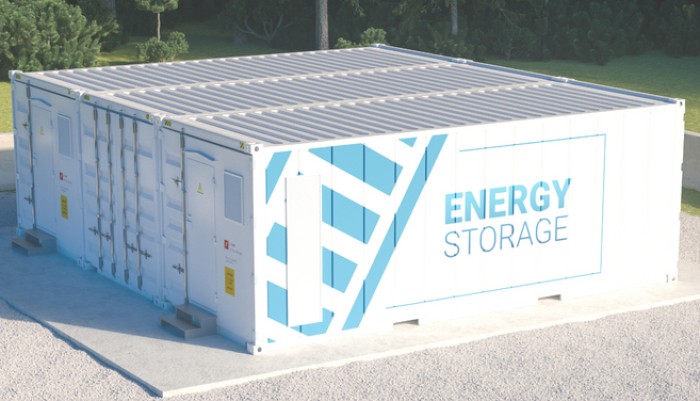Energy Storage is a "Stretch" Resource that is Pivotal to Modernize the Electric Grid
 | Delainey Thorud, Manager, Membership and Operations |

 | Delainey Thorud, Manager, Membership and Operations |
What is Energy Storage?
Energy storage is a "stretch" resource that allows excess energy to be stored until it is needed. It helps bridge the gaps inherent in the output from variable resources like wind and solar, and it can also stretch the number of hours that are powered by clean, affordable renewable energy.
There are many forms of energy storage such as: pumped hydroelectric, thermal energy, compressed air, and flywheel storage. The most common form of energy storage being pursued today, and the one we are most familiar with, is battery storage -- most commonly, lithium-ion batteries. You are probably familiar with these batteries because they are also used in cell phones and electric cars. Lithium-ion batteries are used at large scale battery storage plants to save large amounts of energy that otherwise would have gone unused.
Growth of Energy Storage
Energy storage has been an emerging topic in the renewable energy field but has really started to take off in the last couple of years. According to the American Clean Power Association's (ACP) Q2 2022 Quarterly Report, the United States currently has 6,471 MW of operational utility-scale battery storage, with 1,751 MW added in 2022 alone. Additionally, according to ACP, in the first half of 2022, grid scale storage installations were 247% higher than the first half of 2021. The grid is bursting with interconnection requests for storage, which have reached a whopping 368,319 megawatts (MW) through 2028.
Top 5 Benefits of Energy Storage
1 - Increases Reliability and Resilience of the Grid
Arguably, the greatest benefit of energy storage is the ability to improve the reliability and resilience of the electric grid. While great strides have been made in accommodating wind and solar on the electric grid, they are still variable resources, meaning that the wind doesn't always blow and the sun doesn't always shine. When there is a lull in the amount of energy being produced by renewable resources, battery storage can help make up the difference by releasing stored energy. Additionally, when unexpected events such as extreme weather cause a service disruption, storage is ready and able to step in and help fill the gaps. Battery storage can hold energy generated by clean resources until it is needed on the grid and can be released quickly and on short notice to meet changing needs. This helps ensure that there will be a consistent, reliable stream of power even when unexpected fluctuations in generation supply or energy demand occur. Clean Grid Alliance is working with grid operators to develop "rules of the road" that will help give storage access to the grid and establish how it will participate in the energy market. Getting these rules right will further improve reliability and resilience on the grid.
2 - Saves Consumers Money
Despite the added cost of constructing and maintaining energy storage facilities, energy storage provides financial benefits and savings to consumers. Since energy generated from renewable energy resources is less expensive than energy from fossil fuels, capturing any excess so it can be deployed later makes good economic sense. Furthermore, when there is an excess of clean low-cost renewable energy available, or low demand on the grid, the cost of energy is significantly lower than it is during peak times of demand or during energy shortages. Provided the appropriate market rules are in place, energy storage facilities can capture this low-cost energy and store it. Then, instead of paying a higher rate for energy from resources that have added fuel costs, the grid operator can dispatch low-cost energy from storage facilities, which helps keep costs low for consumers.
3 - Integrates More Renewables
One major benefit of energy storage is that it assists the grid in integrating and delivering more renewable energy. The current electric grid was built for "always available" fossil fuel power plants that could be turned on or turned up when necessary to meet demand. As we transition to an energy grid that has more variable resources, storage can provide the attributes the system needs to instantaneously meet the demand for more energy. For example, as the sun goes down, other resources must be ramped up to continue serving consumer electricity needs. Storage resources can be dispatched during this time to smooth the transition, making it easier for grid operators to ramp up other generators for the evening and stretching the availability of clean resources. Renewables plus energy storage can be operated to mimic a fossil fuel resource. By storing excess renewable energy when it is plentiful and releasing it when it is needed, energy storage can help make renewables as dispatchable as fossil fuels, but without the emissions.
4 - Reduces the Amount of Wasted Energy
While energy storage is extremely helpful in making up for times of low renewable energy production, it also helps when renewables are producing an excess. Over-production occurs when renewable energy generation is high, energy demand is low, or transmission capacity is congested. Without storage, during these times, the abundance of low-cost, clean energy cannot be added to the grid and will be wasted. Energy storage allows us to capture this excess energy and store it until it is needed. This not only reduces the amount of wasted clean energy but can also reduce the amount of higher cost fossil fuel resources needed on the grid to maintain reliability.
5 - Reduces Negative Environmental Impacts
Energy storage helps to reduce environmental impacts in multiple ways. For starters, energy storage produces no emissions and has no air quality or environmental impacts of its own. If charged by renewable resources, it can reduce reliance on fossil fuels, avoiding emissions and harmful greenhouse gases from those resources. When renewable energy production is low, energy storage can step in instead of fossil fuel power plants, stretching out the amount of time that renewables are powering the grid. This helps reduce the amount of harmful emissions and greenhouse gases from entering our air.
It's a fact. Energy storage is a "stretch" resource that is pivotal to modernizing the electric grid.